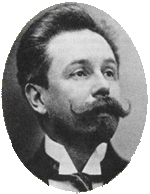2nd Symphony (Scriabin)
The 2nd Symphony in C minor by the Russian composer Alexander Nikolajewitsch Skrjabin (1872–1915) was composed in 1901. The five-movement work was published as his op .
Origin, premiere and reception
Alexander Scriabin's 2nd Symphony was composed largely in the summer of 1901 in Moscow during the semester break at the Moscow Conservatory , where the composer had been a piano professor since 1898. The 1st symphony , composed in the previous year, was decided by a choral finale and the composer initially planned to open his new symphony with vocal parts. Scriabin's patron and publisher Mitrofan Beljajew , however, urgently advised him not to do so and also advised him not to conduct the premiere himself for lack of experience - as Scriabin initially intended.
The first performance of the 2nd symphony took place on July 12th . / January 25, 1902 greg. in St. Petersburg under the direction of Anatoly Lyadow . The work met with a rather perplexed reception in the audience. After the first performance in Moscow in 1903 under Vasily Safonov , Scriabin's aunt Lyubov Alexandrovna reported: " The more one raged, the more the others applauded ." The first performance conductor Lyadow wrote, partly seriously, partly jokingly, to Belyayev: “ The devil knows what that is! Scriabin can boldly shake hands with Richard Strauss [...] After Scriabin, Wagner became an infant with pleasant chirps. "Scriabin's former composition teacher Anton Arensky wrote of" nonsense "and said: " [...] instead of "symphony", "cacophony" should have been printed "[...] . Juri Engel , one of the first Scriabin biographers, stated that this was “ music for the top ten thousand, far from the healthy expanse of fields and forests, grown in the refined and nervous atmosphere of the sultry city [...] but you can feel the new beginning something new, the striving to break the chains of the existing [...] "
Instrumentation and playing time
The score provides for the following scoring : 3 flutes (3rd also piccolo ), 2 oboes , 3 clarinets , 2 bassoons , 4 horns , 3 trumpets , 3 trombones , tuba , timpani , tam-tam , cymbals and strings .
The performance lasts approximately 50 minutes.
Characterization and sequence of sentences
While Scriabin's 1st symphony still had 6 movements, the 2nd symphony has five movements and can be interpreted as a classic 4-movement symphony model with an independent slow introduction. Architecturally, it is shaped by a cyclical idea that brackets the first and last movement in particular with a “guiding theme”, while the second and fourth movements also combine thematic relationships (and the main theme also appears here in a transformed form). Only the third movement, as the center of the work, uses material that is largely motif independent. This leitmotif bracketing, however, is not a new idea of Scriabin; César Franck ( Symphony in D minor ) and Pjotr Tchaikovsky ( 5th Symphony ) had already proceeded in a similar manner. Scriabin's frequent use of high and low-aged chords sometimes blurs the contrasts between major and minor , which may have contributed to the incomprehensible reception of the work by contemporaries, which stylistically follows Richard Wagner , Tchaikovsky and the César Franck school.
I. Andante
The “leading theme”, which dominates large parts of the symphony, appears at the beginning of the movement (a rondo ) in a gloomy, elegiac form in the deep clarinet and also has a stronger influence on the rest of the movement than the more episodic 2nd theme presented by the solo violin.
II. Allegro
The second movement follows the first movement attacca and uses a regular sonata form that combines a restless, pressing main theme with a cantilever clarinet sub-theme.
III. Andante
The expressive, predominantly pastoral middle movement, in turn, uses the sonata form and in its differentiated, naturalistic bird calls in the flute at the beginning of the movement (which are also briefly heard at the end of the movement) almost foreshadow Olivier Messiaen .
IV. Tempestoso
A gruff string theme that is thematically related to the main theme of the 2nd movement characterizes the course of this movement, which takes on the role of the scherzo . The arrangement as a rondo is overlaid by sonata elements.
V. Maestoso
The final follows attacca to the 4th movement. The main theme now appears march-like and triumphant in C major of the full orchestra and leads the movement , which formally forms a sonata rondo , “ in the tone of Wagner's master singers ” to the final apotheosis.
Individual evidence
- ↑ a b Gottfried Eberle: I create you as a diverse unit. Lines of development in Alexandr Scriabin's symphonies . In: Alexander Scriabin and the Scriabinists. Edited by Heinz-Klaus Metzger, Rainer Riehn. Music concepts. Vol. 32/33. edition text + kritik, Munich 1983, ISBN 3-88377-149-X , p. 50
- ↑ a b Gottfried Eberle: I create you as a diverse unit. Lines of development in Alexandr Scriabin's symphonies . In: Alexander Scriabin and the Scriabinists. Edited by Heinz-Klaus Metzger, Rainer Riehn. Music concepts. Vol. 32/33. edition text + kritik, Munich 1983, ISBN 3-88377-149-X , p. 51
- ^ Wulf Konold (Ed.): Lexicon Orchestermusik Romantik. SZ . Piper / Schott, Mainz 1989. ISBN 3-7957-8228-7 , p. 853
literature
- Gottfried Eberle: I create you as a diverse unit. Lines of development in Alexandr Scriabin's symphonies . In: Alexander Scriabin and the Scriabinists. Edited by Heinz-Klaus Metzger, Rainer Riehn. Music concepts. Vol. 32/33. edition text + kritik, Munich 1983, pp. 42–68. ISBN 3-88377-149-X
- Arno Forchert: LP-text to: Alexander Skrjabin, symphonies 1–3, Staatl. Symphony orchestra. of the USSR / Jewgenij Swetlanow (Melodia / Ariola-Eurodisc)
- Wulf Konold (Ed.): Lexicon Orchestermusik Romantik. SZ . Piper / Schott, Mainz 1989. ISBN 3-7957-8228-7 , pp. 850-853
- Sigfried Schibli: Alexander Scriabin and his music . Piper, Munich / Zurich 1983. ISBN 3-492-02759-8 , pp. 214f.
